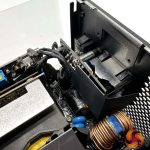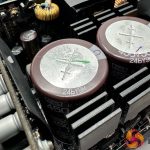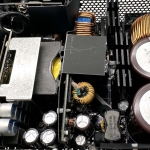FSP are using a 120mm Protechnic Electric Fluid Dynamic Bearing fan – MGA12012XF-025. This is a fan that FSP have favoured for years – we saw the same fan back in our 2019 review of the Hydro G Pro 850W unit (HERE). This fan is rated 12V 0.52A output. It has proved to be a reliable, well made fan over the years. If needed it can also spin to a maximum high rotational speed of 2,700 rpm under use.
Usually we would see a slightly larger fan inside a unit of this power output, but FSP have made the chassis so small (150mm x 130 mm x 86 mm), it is impossible for them to adopt a larger fan.
Below - a High Resolution Gallery of the internal layout of the Power supply.
Unlike many other companies who adopt an OEM partner, FSP create their own power supplies from start to finish. This unit is very well put together and it is a very clean layout with high standards of soldering quality. Filtering begins on the rear of the AC receptacle with four Y capacitors, two X capacitors and two more filtering inductors – a dual input rectifying bridge configuration. The two rectifying bridges have a heatsink between them to aid with reducing temperatures. Additional filtering capacitors are on the PCB which hold the cable connectors.
This unit is a half bridge design adopting only two transistors at the primary side of the transformer. Many manufacturers would adopt a full bridge design for such a highly rated efficiency level as it can often give a little extra efficiency to the overall design.
We are happy to see FSP aren't cutting corners and the primary stage is home to two high capacity 450/500uF 105C-rated Japanese capacitors by Nippon Chemi Con. A large heatsink along the edge of the PCB is home to active APFC components.
The secondary stage of the design is mounted on vertical PCBs. The two boards house the LLC resonant circuitry and the secondary rectification stage which includes the transformer. FPS are using very high grade Toshiba efficiency switchers to help achieve the rating. 3.3V and 5V lines are produced by DC-to-DC conversion – a standard practice for a design such as this.
 KitGuru KitGuru.net – Tech News | Hardware News | Hardware Reviews | IOS | Mobile | Gaming | Graphics Cards
KitGuru KitGuru.net – Tech News | Hardware News | Hardware Reviews | IOS | Mobile | Gaming | Graphics Cards










